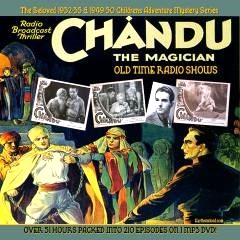
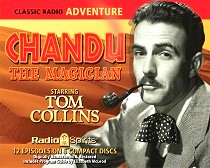 Chandu the Magician (1932-35, 1948-50) aired “The Temple at Karnak” on March 17, 1949 as the 7th of the 13 half-hour episodes in 1949.
Chandu the Magician (1932-35, 1948-50) aired “The Temple at Karnak” on March 17, 1949 as the 7th of the 13 half-hour episodes in 1949.
The first run (1932-35) consisted of daily 15-minute episodes that became popular very quickly, so much so that a 1932 film soon followed the radio adventures of Chandu. The idea behind Chandu the Magician stemmed from the public’s interest at the time with Eastern mysticism and the occult. The Chandu character’s fictional real life name is Frank Chandler. Chandler has spent many years in the Orient studying the mystic arts and is now adept at astral projection, conjuring illusions, and teleportation among other magical abilities he uses when necessary. If this sounds like a familiar set of superpowers it was, witness magazine and radio close contemporaries like the Shadow or Mandrake the Magician—though Chandu on radio was the first. The original story arc sees Chandu chasing after the evil Roxor, who has kidnapped the husband of Chandu’s sister, Dorothy Regent. Chandu and his sister travel to all sorts of exotic locales in search of her husband (who was thought to have disappeared in a shipwreck but later to have disappeared at the hands of Roxor). Roxor, as all truly evil villains are, is bent on conquering the world and will stop at nothing to accomplish his egomaniacal ends. 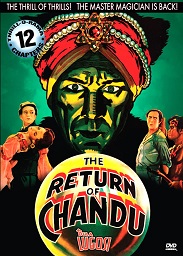 For the original 1932 movie, actor Edmund Lowe played Chandu, while none other than Bela Lugosi took the role of Roxor. For the 1934 sequel, however, in a surprising role reversal Lugosi was honored with the role of Chandu.
For the original 1932 movie, actor Edmund Lowe played Chandu, while none other than Bela Lugosi took the role of Roxor. For the 1934 sequel, however, in a surprising role reversal Lugosi was honored with the role of Chandu.
A crucial bit of the history of the show would be incomplete without mentioning that a great part of the radio show’s success was due to a young woman by the name of Vera Oldham, a former office girl who proved good on her aspirations to write. After the radio series ended in 1935 and the Chandu films were long over, Chandu was resurrected on radio in 1948, with the former story arc refurbished and updated (even bringing back Oldham to touch up the scripts), continuing Chandu’s travels to mysterious and little known parts of the world (the fabled land of Lemuria for one), and gifting him with a love interest of surpassing beauty in the character of the Egyptian princess Nadji.
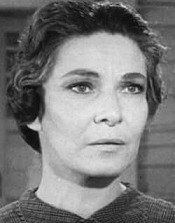
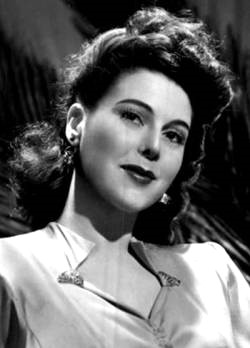 For the 1948-50 radio revival, the episodes from June of 1948 through the end of January 1949 were daily 15-minute episodes, then from February of 1949 through the final show on September 6, 1950 Chandu would become full half hour, self-contained stories, of which this week’s episode is one. Tom Collins (1913-73, photo top right) would become the new voice of Chandu, Irene Tedrow played his sister Dorothy, and the talented film actress Veola Vonn (1918-1995, photo at left) was Princess Nadji. In this episode, however, Princess Nadji is played by Lillian Buyeff (1920-2001, photo at right from an appearance on Perry Mason) who would also go on to enjoy a successful film and TV career after her radio days were behind her.
For the 1948-50 radio revival, the episodes from June of 1948 through the end of January 1949 were daily 15-minute episodes, then from February of 1949 through the final show on September 6, 1950 Chandu would become full half hour, self-contained stories, of which this week’s episode is one. Tom Collins (1913-73, photo top right) would become the new voice of Chandu, Irene Tedrow played his sister Dorothy, and the talented film actress Veola Vonn (1918-1995, photo at left) was Princess Nadji. In this episode, however, Princess Nadji is played by Lillian Buyeff (1920-2001, photo at right from an appearance on Perry Mason) who would also go on to enjoy a successful film and TV career after her radio days were behind her.
This episode begins with Chandu and company in Beirut, always on the trail of his sister’s husband, but along the way discovering the story of a Nazi war criminal who has a large hidden stash of deadly poison gas he will unleash on the world unless Chandu can find him, foil his plot, and save the world. Their journey takes them to Egypt and a dangerous and near-death chase in the unwelcoming depths of “The Temple at Karnak.”
Play Time: 29:40
{This episode of Chandu the Magician aired on a Thursday evening in mid-March of 1949, so the following day after school meant the start of another weekend and a trip to the nearby newsstand on the way home from school for the neighborhood gang. Selections this visit varied (and were limited in part to what they had already bought and what was still available), but in short order the following selections were in hand. Detective Mystery Novel Magazine (1935-51) underwent a trio of title changes over the years, the title below running from 1948-1949, with a final change for its final two years, 1950-51. Though a quarterly in 1949 it managed only 3 of its 4 issues, missing its summer issue. One of the reasons for the magazine’s success was its ability to attract top tier talent, witness Leslie Charteris’ name on the cover of the issue below, Charteris being the creator of one of the most iconic detectives in the genre, the Saint. Detective Tales (1935-53) helped stock newsstand shelves for all of 18 years and a whopping 202 issues, most boasting a full dozen (and later 15) stories. It was a monthly in 1949. Famous Fantastic Mysteries (1939-53) earned its fame by reprinting “scientific and fantastic classics” and was an immediate hit with its first issue, featuring among its 7 stories A. Merritt’s The Moon Pool and Ray Cummings’ The Girl in the Golden Atom. Edited by Mary Gnaedinger and with the incomparable Virgil Finlay as the publication’s foremost illustrator, its success was a foregone conclusion. Though its schedule was often erratic, from 1946-52 it held steady as a bimonthly.}
[Left: Detective Mystery Novel, Spring/49 – Center: Detective Tales, 3/49 – Right: Famous Fantastic Mysteries, 2/49]
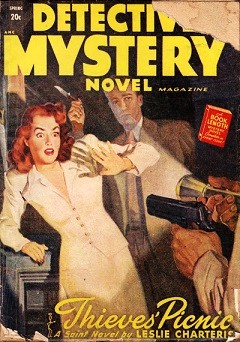
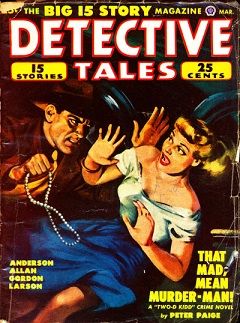
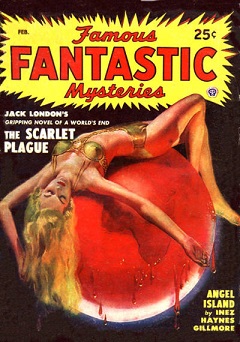
To view the entire list of weekly Old Time Radio episodes at Tangent Online, click here.